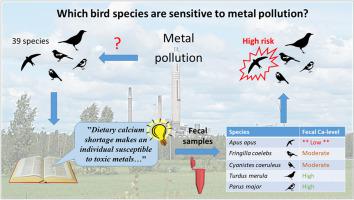当前位置:
X-MOL 学术
›
Environ. Pollut.
›
论文详情
Our official English website, www.x-mol.net, welcomes your
feedback! (Note: you will need to create a separate account there.)
Fecal calcium levels of bird nestlings as a potential indicator of species-specific metal sensitivity
Environmental Pollution ( IF 7.6 ) Pub Date : 2024-01-16 , DOI: 10.1016/j.envpol.2023.123181 S Espín 1 , T Andersson 2 , M Haapoja , R Hyvönen , E Kluen 3 , H Kolunen , T Laaksonen 4 , J Lakka , L Leino 4 , K Merimaa 4 , J Nurmi 4 , M Rainio 4 , S Ruuskanen 5 , K Rönkä 3 , P Sánchez-Virosta 1 , J Suhonen 4 , P Suorsa , T Eeva 4
Environmental Pollution ( IF 7.6 ) Pub Date : 2024-01-16 , DOI: 10.1016/j.envpol.2023.123181 S Espín 1 , T Andersson 2 , M Haapoja , R Hyvönen , E Kluen 3 , H Kolunen , T Laaksonen 4 , J Lakka , L Leino 4 , K Merimaa 4 , J Nurmi 4 , M Rainio 4 , S Ruuskanen 5 , K Rönkä 3 , P Sánchez-Virosta 1 , J Suhonen 4 , P Suorsa , T Eeva 4
Affiliation

|
Sensitivity of bird species to environmental metal pollution varies but there is currently no general framework to predict species-specific sensitivity. Such information would be valuable from a conservation point-of-view. Calcium (Ca) has antagonistic effects on metal toxicity and studies with some common model species show that low dietary and circulating calcium (Ca) levels indicate higher sensitivity to harmful effects of toxic metals. Here we measured fecal Ca and five other macroelement (potassium K, magnesium Mg, sodium Na, phosphorus P, sulphur S) concentrations as proxies for dietary levels in 66 bird species to better understand their interspecific variation and potential use as an indicator of metal sensitivity in a wider range of species (the main analyses include 39 species). We found marked interspecific differences in fecal Ca concentration, which correlated positively with Mg and negatively with Na, P and S levels. Lowest Ca concentrations were found in insectivorous species and especially aerial foragers, such as swifts (Apodidae) and swallows (Hirundinidae). Instead, ground foraging species like starlings (Sturnidae), sparrows (Passeridae), cranes (Gruidae) and larks (Alaudidae) showed relatively high fecal Ca levels. Independent of phylogeny, insectivorous diet and aerial foraging seem to indicate low Ca levels and potential sensitivity to toxic metals. Our results, together with information published on fecal Ca levels and toxic metal impacts, suggest that fecal Ca levels are a promising new tool to evaluate potential metal-sensitivity of birds, and we encourage gathering such information in other bird species. Information on the effects of metals on breeding parameters in a wider range of bird species would also help in ranking species by their sensitivity to metal pollution.
中文翻译:

雏鸟粪便钙水平作为物种特异性金属敏感性的潜在指标
鸟类对环境金属污染的敏感性各不相同,但目前没有通用框架来预测物种特异性敏感性。从保护的角度来看,此类信息非常有价值。钙 (Ca) 对金属毒性具有拮抗作用,对一些常见模型物种的研究表明,膳食和循环钙 (Ca) 水平较低表明对有毒金属的有害作用具有更高的敏感性。在这里,我们测量了粪便中的钙和其他五种常量元素(钾 K、镁 Mg、钠 Na、磷 P、硫 S)浓度,作为 66 种鸟类饮食水平的代理,以更好地了解它们的种间变异和作为金属敏感性指标的潜在用途更广泛的物种(主要分析包括39个物种)。我们发现粪便 Ca 浓度存在显着的种间差异,其与 Mg 呈正相关,与 Na、P 和 S 水平呈负相关。食虫物种中的钙浓度最低,尤其是空中觅食者,例如雨燕(Apodidae)和燕子(Hirundinidae)。相反,八哥(Sturnidae)、麻雀(Passeridae)、鹤(Gruidae)和云雀(Alaudidae)等地面觅食物种的粪便钙含量相对较高。与系统发育无关,食虫饮食和空中觅食似乎表明钙含量较低并且对有毒金属具有潜在敏感性。我们的结果,加上有关粪便钙水平和有毒金属影响的信息,表明粪便钙水平是评估鸟类潜在金属敏感性的一个有前途的新工具,我们鼓励在其他鸟类中收集此类信息。 有关金属对更广泛鸟类繁殖参数影响的信息也将有助于根据对金属污染的敏感性对物种进行排名。
更新日期:2024-01-16
中文翻译:

雏鸟粪便钙水平作为物种特异性金属敏感性的潜在指标
鸟类对环境金属污染的敏感性各不相同,但目前没有通用框架来预测物种特异性敏感性。从保护的角度来看,此类信息非常有价值。钙 (Ca) 对金属毒性具有拮抗作用,对一些常见模型物种的研究表明,膳食和循环钙 (Ca) 水平较低表明对有毒金属的有害作用具有更高的敏感性。在这里,我们测量了粪便中的钙和其他五种常量元素(钾 K、镁 Mg、钠 Na、磷 P、硫 S)浓度,作为 66 种鸟类饮食水平的代理,以更好地了解它们的种间变异和作为金属敏感性指标的潜在用途更广泛的物种(主要分析包括39个物种)。我们发现粪便 Ca 浓度存在显着的种间差异,其与 Mg 呈正相关,与 Na、P 和 S 水平呈负相关。食虫物种中的钙浓度最低,尤其是空中觅食者,例如雨燕(Apodidae)和燕子(Hirundinidae)。相反,八哥(Sturnidae)、麻雀(Passeridae)、鹤(Gruidae)和云雀(Alaudidae)等地面觅食物种的粪便钙含量相对较高。与系统发育无关,食虫饮食和空中觅食似乎表明钙含量较低并且对有毒金属具有潜在敏感性。我们的结果,加上有关粪便钙水平和有毒金属影响的信息,表明粪便钙水平是评估鸟类潜在金属敏感性的一个有前途的新工具,我们鼓励在其他鸟类中收集此类信息。 有关金属对更广泛鸟类繁殖参数影响的信息也将有助于根据对金属污染的敏感性对物种进行排名。


















































 京公网安备 11010802027423号
京公网安备 11010802027423号